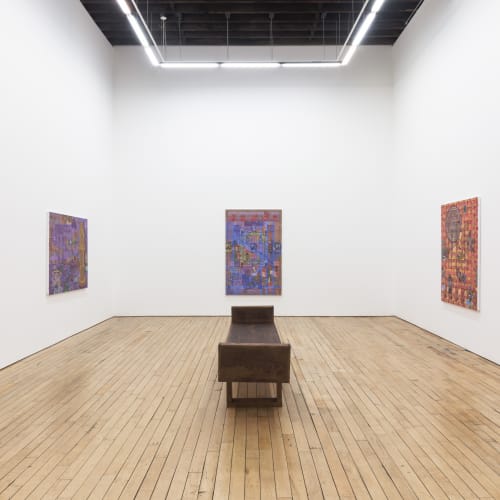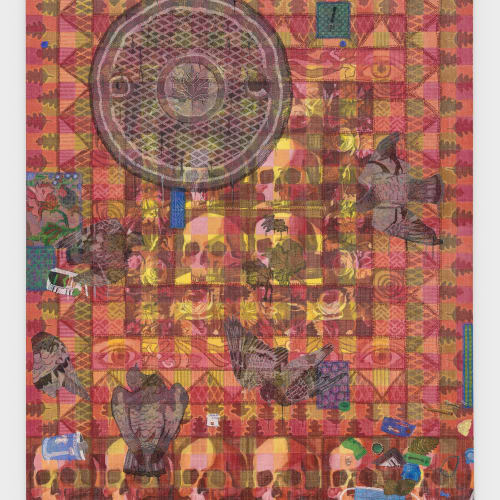Clare Gemima
May 31, 2023
Schmatta, derived from Yiddish, translates to "rag," a phrase that gained popularity in the late 19th century as an influx of Eastern European Jewish immigrants entered the garment trade. Brooklyn based painter Talia Levitt utilizes this term as an endearing descriptor for her twelve expansive quilt-like artworks, currently hanging at Rachel Uffner Gallery in New York. Remaining faithful to her recurring themes, Levitt delves into the realm of women's bodies and labor, serving as reminders of mortality, the historical aspects of painting, as well as her strolls through the streets of New York City. Her deep affection for textiles developed through her familial influences and an inherent desire to express herself through manual creation, ultimately realized via the fascinating studio production line that allows her to add a billion details into one contained canvas. In this conversation, Levitt discusses the inspiration behind the exhibition's title and her painterly portrayals of life within New York’s rich but morbid tapestry.
Clare Gemima (CG): Talia, congratulations on your first solo show. These works are highly detailed. It is really hard to know where to start. You mentioned you had around eleven to twelve months to paint all twelve of these works. I’m curious, at which point did you decide your exhibition would be called Schmatta?
Talia Levitt (TL): I actually decided on the title before the works were made. The term operated like the North Star, guiding my work and keeping the show on track. I wanted to make a body of work that required me to research New York City and its garment industry, while at the same time presenting something that I felt deeply about and that was special. For me, the term “schmatta” encapsulated everything.
CG: Your paintings make historical references to the large Yiddish speaking Jewish population that immigrated to the Lower East side in the 1800’s, without forgetting the setting today, in 2023, when getting a coffee from your local bodega involves stepping over a dead pigeon or rat at least twice. Do you feel that you’ve balanced portraying a personal sentimentality in your paintings through the depiction of life in your New York?
TL: That’s a tricky one, only because the ‘personal sentimentality’ that comes through in the artworks is more authentic than it is strategized. I will say though that the worn appearance of the work, like the distress of the scraping, and the dangling of fake stitches, do make the paintings appear loved…somehow? Like a favorite dress worn to shreds. This provides for much leeway in terms of the aspects of New York City that these works actually aim to depict. Additionally, I take a lot of photos during my commute between my home and the studio, which allow for contemporary/personal imagery that balances out historical research.
CG: Can you walk us through the work’s production process, from the canvas’ underlying layers, right through to the placement of your miniature paint molds?
TL: I often start with a thumbnail sketch that would be illegible to the common viewer, and then size up the drawing more considerately on a canvas. In the works on view at Rachel Uffner Gallery, I broke up the paintings into geometric shapes which were then colorblocked and filled with imagery. Then, I used a knife and a ruler to scrape a tight grid over the entirety of each work, which is what gives the paintings a worn, textile appearance. I then sealed them with a clear acrylic gloss to protect the paint from flaking off, and afterwards used sandwich bags to pipe out the embroidery. Lastly, I casted little objects made out of paint in silicone molds, and embellished the work with acrylic glitter. I know this all sounds extremely regimented, but a huge amount of improvisation happens throughout.
CG: How did you end up using a sandwich bag to paint? It feels like a studio invention that may have come to you by complete accident?
TL: Painting has always been a ‘necessity is the mother of invention’ type of thing for me, which I think is backwards for some painters. I consider the materials or surfaces I need in each painting and figure out how to best represent them. The sandwich bag technique, like cake icing, is quite convincing as embroidery, and I’ve actually learned a lot of techniques from the baking community.
CG: When we spoke about the paintings in the gallery, you lit up talking about your background in children’s book illustration. How do you believe this aspect of your career has influenced your new body of work?
TL: Oooh that is an interesting question, and I’m glad you asked because for a long time I was a little bashful about my background in illustration, but now I am able to see it as an asset. In addition to having had much drawing training in the illustration department in undergrad (which I heavily rely on now), I think a lot about narrative, composition and legibility in my work. I feel confident about developing paintings that rebel against ideas like these, that challenge what the term illustration could more commonly conjure for my audience.
CG: Your mother is a large part of your work, recurring in several paintings, like Mom (2023), which was concurrently on view at NADA’s May art fair. I am curious to know more about her, but specifically about the collaboration between you two for this exhibition.
TL: My parents often make furniture together for their home, among other wood-based projects. They actually made the bench currently installed at the gallery. We collaborated to design something inspired by those on the subway platforms, but without dividers or a back. So, their work is front and center in the show. My mom did a lot of research on how to recreate the surface of a subway bench to make ours look authentic. It worked out so well that the varnish company is using the work for publicity! I guess her interest in detail and sensitivity to material was passed down… My mom is also my most honest critic, she visits the studio more often than anyone else, and doesn’t suppress her opinions, related information, or stories when it comes to the work, which is all welcomed and very much appreciated.





